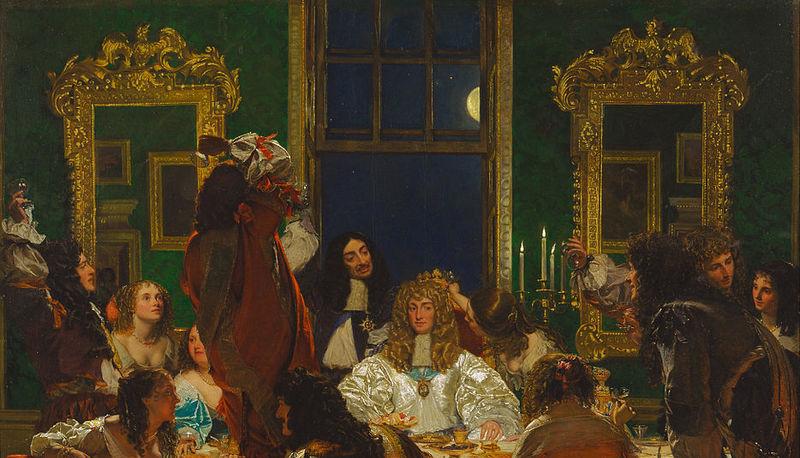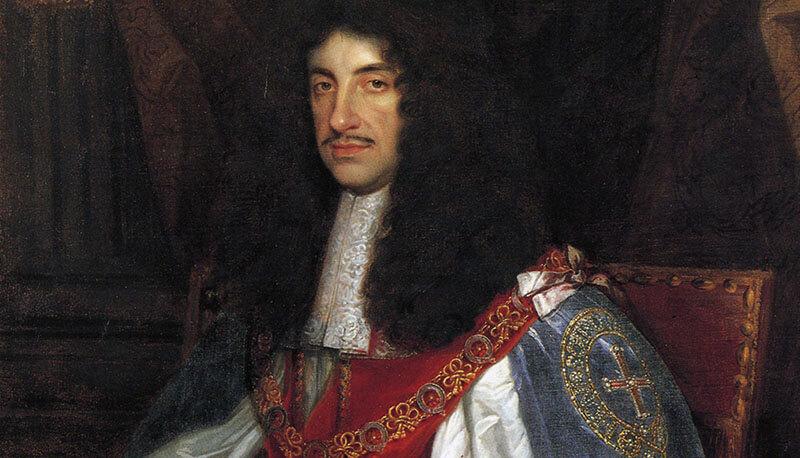Concetti Chiave
- The Restoration of Monarchy saw Charles II, influenced by French culture, returning to the throne, leading to the formation of Britain's first political parties, Whigs and Tories.
- The Glorious Revolution marked a bloodless transition of power where William of Orange took the throne, leading to the Bill of Rights and establishing Parliament's authority over the monarchy.
- During the Reaction to gloom, the upper class rebelled against Puritan morality, embracing a lifestyle of fashion, dance, and entertainment, differing from the simpler lifestyle of merchants.
- The period of Wit and science was characterized by a shift towards classical simplicity, the influence of rationalist philosophers, and scientific advancements by figures like Newton, promoting reason and experience.
- The enjoyment of the senses in Restoration theatre included innovative features like roofed venues and professional actors, with the Comedy of Manners satirizing the elite's absurdities.
Charles I was succeeded by his son Charles II. He was a merry monarch because he’s conditioned by French tastes and sympathies; he admired the magnificent court of Louis XIV under that he lived. He was a cultured man, more intelligent and less fanatic than his father. The Parliament that recalled the king to return on the throne was called Cavalier Parliament. In 1673 Parliament forced the king to sign a Test Act, in which Catholics were denied in holding public offices.
Indice
La nascita dei partiti politici
The fear of Charles’s interest in Catholic Church and of the monarchy becoming so powerful resulted in the formation of the two first parties in Britain:
The Whigs, a Scottish name meaning “cattle raiders” are the descendants of supporters of Parliament. They don’t believe in absolute power, either of Church or State, and stood for the toleration of dissenters. The Tories or “outlaws” were the descendants of Royalists. They supported the Crown, the Anglican Church and the landed gentry. They believe that the kings’ government was given by a divine right.

La Gloriosa Rivoluzione
The Tory party decided to crown a new king, James II, although he was Catholic. The king early decided that he was enough strong to impose Catholicism in England, because he grow up in France. But his daughters, Mary and Anne, were both Protestants and did not approve their father’s policy. Abroad the Dutch William Orange, worried that England would side with Louis XIV against Protestant Holland, went in England to stop the dangerous movement of James. So William took secretly the throne in 1688 and James was forced to go away. Thus William entered London without firing a single shot or shedding a drop of blood. This was the Glorious Rev.
The power of Parliament was superior to the one of the King; in fact William had to sign the Bill of Rights in 1689. The king was unable to raise taxes or keep an army without Parliament’s agreement. In these years was left the Toleration Act, in which Protestant dissenters had not to be persecuted.
Il regno di Anna e la moda
William was succeeded by Anne, younger sister of his wife Mary. Queen Anne favoured the Whigs and her reign was marked by England’s intervention in the war of Spanish succession. The war ended with the Treaties of Utrecht (1713) in which England kept Gibraltar and the monopoly of slave in colonies of South America. With the Union Act (1707) Scotland lost its parliament, but Scotsmen can sit both in the House of Lords and Commons, so they were represented in English Parliament.
During the Civil War, England was quacked by a Puritans’ strict view of life. The behaviour of the upper class and the aristocracy showed a strong reaction against the strict puritan morality. The aristocratic people love dancing, playing cards and they enjoyed making love. Both men and women cared for fashion and appearance. Men wore wigs and rich clothes of bright colours. Women wore wigs too and long dressed with low neck-lines. Oak wood was replaced by other woods, the seats and backs of the chairs were covered by rich clothes and ornamental tapestry.
The fashions set by King and aristocracy was copied by middle-class. But merchants and traders preferred a purer and simpler life style.

La transizione della Restaurazione
The Restoration was a period of transition form the recent past to the next period of scientific innovations and of a change of mentality of men. For example complexity was transformed into classical simplicity and wit does not consist of striking surprise but the exercise of reason. The true spirit of Restoration was satirical due to the study of classical writer like Horace and Martial.
A minor group of poets continued the lyrical tradition copying the Cavalier Poets. They were aristocrats dominated by the influence of a superficial life and its ideals of elegance. The most important poet who stands these elements was
In Restoration you can see also the rational tendencies, available in the works of the rationalists philosophers They insisted that the fundamental source of human knowledge of the whole world is only the experience, gained through the senses. Experience and reason could not be separated and became the key-words of 18 century. Hobbes defended the absolute monarchy with the figure of Leviathan, which is the union of power of every person. Newton’s new theories were published and learned by the society.
Il teatro della Restaurazione
Restoration theatres were roofed and artificially lit with candles and painted movable scenery.
Actors and actress became professional and they were tied to the theatre through a contract. The audience belonged to nobility and the theatre was seen as a point of meeting for people and allows the people to fell fashionable. The best literary expression of Restoration drama was the Comedy of Manners which made fun on the manners and the absurdities of elegant society: it was witty, coarse, cynical and satirical.
A more naturalistic style of acting was used, scenery would confirm the impression of each situation, a world smaller and more familiar was set into recitation. The strongest influence for the Restoration drama was given by
Domande da interrogazione
- Quali furono le conseguenze della Restaurazione della Monarchia in Inghilterra?
- Cosa caratterizzò la Gloriosa Rivoluzione del 1688?
- Come reagì l'aristocrazia inglese alla morale puritana durante la guerra civile?
- Quali furono le tendenze intellettuali durante la Restaurazione?
- Quali furono le caratteristiche principali del teatro durante la Restaurazione?
La Restaurazione portò al ritorno di Carlo II al trono, influenzato dai gusti francesi. Il Parlamento, preoccupato per l'interesse di Carlo verso il Cattolicesimo, portò alla formazione dei primi due partiti britannici: Whigs e Tories.
La Gloriosa Rivoluzione vide l'ascesa al trono di Guglielmo d'Orange senza spargimento di sangue. Il Parlamento acquisì potere superiore al re, che dovette firmare il Bill of Rights, limitando il potere monarchico.
L'aristocrazia reagì alla morale puritana con un forte interesse per il ballo, il gioco d'azzardo e la moda. Gli uomini e le donne curavano l'apparenza, indossando parrucche e abiti ricchi di colori vivaci.
La Restaurazione fu un periodo di transizione verso innovazioni scientifiche e cambiamenti mentali. La satira e la ragione divennero centrali, influenzate da scrittori classici e filosofi come Locke e Hobbes.
I teatri erano coperti e illuminati artificialmente, con scenografie mobili. La Commedia di Costume era la forma letteraria principale, caratterizzata da satira e cinismo, influenzata da Ben Johnson e Molière.








 Accedi a tutti gli appunti
Accedi a tutti gli appunti
 Tutor AI: studia meglio e in meno tempo
Tutor AI: studia meglio e in meno tempo